RHS awarded plants
by Diane - May 9th, 2014.Filed under: Crocus.

Acer japonicum ‘Aconitifolium’ (full-moon maple) £19.99
Position: full sun or partial shade Soil: fertile, moist, well-drained neutral to acid soil Rate of growth: slow-growing Flowering period: April to May Flower colour: purple-red Other features: stunning autumn colour Hardiness: fully hardy An elegant maple that is one of the best for autumn colour. It can be grown as a small, spreading tree or multi-stemmed shrub and is brilliant for adding achitectural interest. Before the leaves emerge in spring, it produces small clusters of purple-red flowers, which are quite pretty up close, but don’t make much of an impact from a distance. The mid green, deeply cut foliage has a fern-like appearance and will turn spectacular shades of red and orange in autumn – especially when grown in partial shade. A super plant that has been awarded the coveted Award of Garden Merit by the RHS. Garden care: Add a top-dressing of organic matter around the base of the plant in autumn. No routine pruning is required, just remove any dead, damaged or crossing branches in late autumn or winter when they are fully dormant. As the leaves may scorch in full sun on a summers day, try to plant it so it gets some protection during the hottest part of the day and shelter from cold winds.
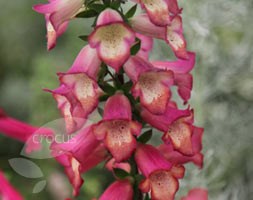
Digitalis Illumination Pink (‘Tmdgfp001’) (Illumination Series) (foxglove) £9.99
Position: full sun or partial shade Soil: moist, humus-rich soil Rate of growth: average to fast-growing Flowering period: June to July Hardiness: fully hardy Winner of a string of awards including the prestigeous Plant of the Year in 2012 at the RHS Chelsea Flower Show, this magnificent new foxglove is a real head-turner. It has exotic-looking flowers, which are a rich blend of sunset tones, and they appear for over a long period on sturdy, branching stems. These plants are mainly biennial so will flower in their second year and then die off. Garden care: Ensure that the soil is kept moist in summer. After flowering cut back the flowered spikes to encourage more sideshoots. Apply a generous 5-7cm (2-3in) mulch of well-rotted organic matter around the plant in early spring.

Sedum spectabile (Brilliant Group) ‘Brilliant’ (ice plant) £7.99
Position: full sun or partial shade Soil: moderately fertile, well-drained, neutral to slightly alkaline soil Rate of growth: average to fast-growing Flowering period: August to November Flower colour: bright pinkish-mauve Other features: attractive to butterflies and bees; the dried flower-heads provide colour and structure in the winter garden Hardiness: fully hardy Succulent, grey-green leaves, topped with large, flat heads of bright pinkish-mauve flowers in summer. This award-winning ice plant looks great planted in bold drifts towards the front of a sunny, well-drained border. A valuable late source of nectar for butterflies and bees, the flat flowerheads make attractive dried-flowers. Garden care: The flowerheads look great left during the winter to add shape and texture to your border. In February and March cut back the old flowerheads and apply a generous 5-7cm (2-3in) mulch of well-rotted garden compost or manure around the base of the plant. Once established, sedums can have a tendency to flop leaving an open and unsightly centre, especially in fertile soil. One technique to help prevent this is the ‘Chelsea chop’. During the last week of May (RHS Chelsea Flower Show week), cut one in every three stems back to the ground. This will produce plants that are less lush and flower slightly later.
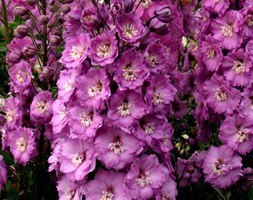
Delphinium elatum ‘Sweethearts’ (New Millennium Series) (delphinium) £7.99
Position: full sun Soil: fertile, well-drained soil Rate of growth: average Flowering period: June and July Hardiness: fully hardy Heralded as the best pink delphinium, ‘Sweethearts’ produces magnificent spires of large, rich rose pink flowers. It is a sturdy grower that has been given the Award of Garden Merit by the RHS because of its vigour and reliability. Delphiniums are excellent in the mixed or herbaceous border if you want to create vertical interest, and for best effect they should be planted in odd-numbered clumps or drifts. To encourage a second flush of flowers in late summer you should cut the flowered stems back as soon as they have finished. Garden care: For best results, choose an open spot away from taller plants. Stake with bamboo canes as they start to shoot upwards in mid-spring and protect young foliage against slug and snail damage. During the growing season, apply a balanced liquid fertiliser every 2-3 weeks and wearing gloves cut back the faded flower-stems to a flowering side-shoot to encourage repeat flowering. At the end of autumn cut back and compost the faded flower stems.

Lathyrus odoratus ‘Charlie’s Angel’ (spencer sweet pea Charlies Angel) £6.99
‘Charlie’s Angel’ was chosen by BBC Gardeners World magazine (July 2011) as the ‘best ever’ sweet pea. They say that ‘this exceptional variety blooms for a long period and has superb perfume making it good for garden display, cut blooms or showing. ‘Charlie’s Angel’ was also the first ever spencer type sweet pea to receive the RHS Award of Garden Merit. These sweet peas are autumn sown and grown in root trainers to promote longer deep roots. They have been grown under a cold polythene tunnel and we will despatch them as soon as they are ready to be planted outside. (See the dates above for the estimated despatch date) Position: full sun Soil: fertile, humus-rich, well-drained soil Rate of growth: average to fast-growing Flowering period: June to September Flower colour: lavender-blue Other features: highly scented flowers Hardiness: hardy annual Highly scented lavender-blue flowers add an alluring touch to cottage gardens or informal planting schemes, when they can be allowed to scramble over supporting obelisks, arches or trellis. Their soft colouring mixes well with stronger purples, blues and pinks. Garden care: Incorporate lots of well-rotted organic matter in the planting hole. To make sure you keep the plants in top condition spray regularly with a fungicide as all sweet peas are prone to mildew, and feed with a high potash fertiliser, such as Tomorite for plenty of flowers. Don’t forget to keep cutting the flowers so that you get plenty more!
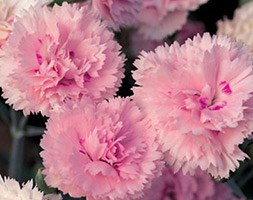
Dianthus Candy Floss (‘Devon Flavia’) (Scent First Series) (PBR) (pot pink) £4.99
Position: full sun Soil: rich but well-drained, alkaline to neutral soil Rate of growth: average Flowering period: May to August Flower colour: soft pink often with a darker eye Hardiness: fully hardy A recently introduced perennial, which has already won itself the RHS Award of Garden Merit. Its soft pink petals, which look as though they have been neatly trimmed with pinking shears, are flecked with crimson towards their base. They form exquisite flowers, that have a strong clove-like scent, on stout stems above the clumps of grey-green foliage. Unlike many other pinks, they will flower whenever it is warm enough, which usually ensures a bumper crop of flowers over a longer period from late spring to summer. Garden care: Dianthus should be trimmed back lightly after flowering to promote new basal growth. Prune more closely in spring, as new shoots emerge to maintain a tidy shape. To maintain healthy growth, it is important to make sure the plants are protected from excessive winter wet.
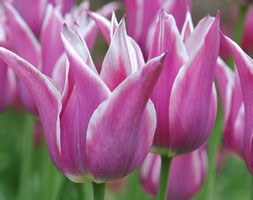
Tulipa ‘Ballade’ (lily flowered tulip bulbs) £3.99
Position: full sun Soil: fertile, well-drained soil Rate of growth: average Flowering period: May Flower colour: violet, edged with white Other features: excellent cut-flowers Hardiness: fully hardy Bulb size: 12/+ A gorgeous lily-flowered tulip with soft violet-mauve flowers that have well-defined white margins and elegantly pointed petals. It is a good, weather-resistant, border tulip which usually comes back reliably year after year without lifting. The flowers are showy and long- lasting and look very similar to the ‘Star Gazer’ lily when fully open. Such a great performer the RHS have not only awarded it the coveted Award of Garden Merit, but also selected it in their list of top 10 tulips. Not bad at all! Garden care: In September to December plant bulbs 15-20cm deep and 10-15cm apart in fertile, well-drained soil. Alternatively, allow 7-9 bulbs per 30cm sq. After flowering dead-head and apply a balanced liquid fertiliser each week for the first month. Once the foliage has died down naturally lift the bulbs and store in a cool greenhouse.

Narcissus ‘Carlton’ (large cupped daffodil bulbs) £3.99
Position: full sun or partial shade Soil: well-drained soil Rate of growth: average Flowering period: April Flower colour: yellow Other features: excellent as cut-flowers; contact with the sap may cause skin irritation Hardiness: fully hardy If you love the big, blousy, traditional daffodils, then you are going to want to include some of these in your garden. This variety is grown extensively for the cut flower trade as their blooms are so robust and long lived. It has been around for nearly one hundred years, is one of the first daffs into flower, and as it is so vigorous it is perfect for naturalising. It is such a fabulous plant it has deservedly been given the prestigious Award of Garden Merit by the RHS. Garden care: Plant 10-15cm (4-6in) deep from late summer to early autumn. After flowering feed with a balanced fertiliser, dead-head and allow the leaves to die back naturally.

Narcissus ‘Dutch Master’ (trumpet daffodil bulbs) £2.99
Position: full sun or partial shade Soil: well-drained soil Rate of growth: average Flowering period: April Flower colour: yellow Other features: excellent as cut-flowers; contact with the sap may cause skin irritation Hardiness: fully hardy Very early flowering Trumpet Yellow daffodil Plant from September to the end of November. Suitable for gardens or indoor forcing. Ideal as a cut flower. It is such a lovey trumpet daffodil it has deservedly been given the prestigious Award of Garden Merit by the RHS. Garden care: Plant 10-15cm (4-6in) deep from late summer to early autumn. After flowering feed with a balanced fertiliser, dead-head and allow the leaves to die back naturally.
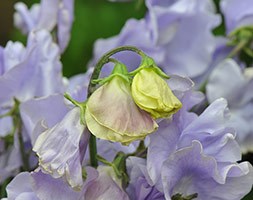
Lathyrus odoratus ‘Charlie’s Angel’ (spencer sweet pea seed Charlies Angel) £1.99
sweet pea Charlie’s Angel as chosen by BBC Gardeners World magazine (July 2011) as the best ever sweet pea. They say ‘This exceptional variety blooms for a long period and has superb perfume making it good for garden display, cut blooms or showing. Charlie’s Angel was the first ever spencer type sweet pea to receive the RHS Award of Garden Merit. Position: full sun Soil: fertile, humus-rich, well-drained soil Rate of growth: average to fast-growing Flowering period: June to September Flower colour: lavender-blue Other features: highly scented flowers Hardiness: hardy annual Highly scented lavender-blue flowers add an alluring touch to cottage gardens or informal planting schemes, when they can be allowed to scramble over supporting obelisks, arches or trellis. Their soft colouring mixes well with stronger purples, blues and pinks. Garden care: From October to late February, sow seeds into deep pots or root trainers filled with a good-quality seed compost and place them in a cold frame. Pinch out the tips as the plants grow to encourage them to become bushier and produce more flowers, and harden off before planting out in early April. Direct sowings can also be made in October or March-April. It is important to remove the faded flowers before they set seed, so picking them to fill a vase inside will only encourage more to form. Sow: October-April Flowering: June-September Approximate quantity: 20 seeds.






